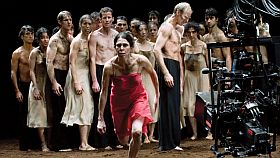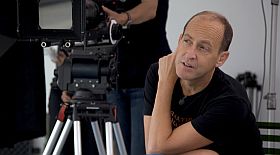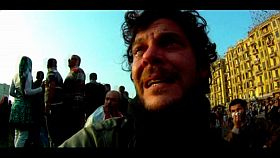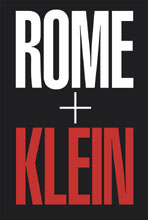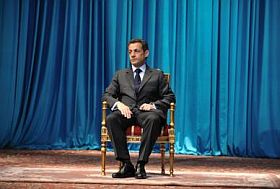Anmeldelsen af Fergusons film førte en diskussion med sig. Først en kommentar her på filmkommentaren.dk af Mikkel Stolt, hvorefter diskussionen sidste weekend fortsatte på Katrine Kiilgaards Facebookside.
Mikkel Stolt: Den film har vi diskuteret meget her på kontoret, og jeg hælder til at være lidt uenig med dig. Personligt finder jeg den mere intellektuelt imponerende end engagerende. Jeg tror ikke, at endeløse billeder af ansigter, grafer og bygninger parret med manglende tid til refleksion og følelsesmæssig involvering er den rette metode til at fortælle den her frygtelige og vigtige historie på film. Filmen har sine øjeblikke (især mod slutningen) men som film eller værk betragtet stiller jeg mig skeptisk. Det svarer næsten til at sige, at en finansrapport er god litteratur. Desuden er den på kanten af at være selvretfærdig og postulerende (og det her siges af en ræverød anti-kapitalist, som meget gerne ville forstå), og jeg ville selv foretrække en vinkel, der gjorde begivenhederne mere menneskeligt begribelige eller vendte ting om eller stillede ting på hovedet. Jeg ved ikke hvordan præcis, men jeg tænkte bl.a. følgende undervejs: Hvorfor fik bestyrelsesmedlemmerne så store bonusser, når nu de var så dårlige til deres job? Fordi de var GODE til deres job – de skaffede sig selv og deres venner kæmpe afkast. Og er vi selv ikke alle forblændet af udsigten til at tjene kassen uden at løfte en finger? En film skal efter min mening bringe sig selv eller sit publikum i spil, når det handler om noget så vigtigt for os alle. Men jeg kan se på Mette Hoffmanns Facebook-væg, at DR er tilfreds med seertal og debat, så måske er det bare mig.
Katrine Kiilgaard: Jeg forstår dine indvendinger, Mikkel. Det er en meget intellektuel film, og den udnytter måske således ikke de oplagte filmiske virkemidler, men det er at gå for langt at ligne den med en økonomisk rapport. Således er jeg enig med Allan i, at den fuldstændigt uforlignelige, tørre interviewteknik og denne række af ansigters reaktion herpå jo giver os noget, vi ikke kunne have læst i en rapport.
Mikkel Stolt: Måske gik jeg for langt i min utilfredshed, for jeg nød også flere aspekter af filmen. Ikke desto mindre ser jeg nogle skismaer, som netop er udtryk for dokumentarfilmens svøbe: Er emnet altid vigtigere end formen? Var frugtskålen vigtigere end penselstrøgene for van Gogh? Vi skal huske, at vi taler toppen af poppen af dokumentarfilm her; en fuckin’ Oscar-vinder! Så for mig er det her en helt essentiel diskussion vedr. dokumentarfilmen som kunstart: Er denne film information eller kunst?
Foto: Charles Ferguson under optagelserne af “Inside Job”.
Ydermere er jeg ikke vild med film, der helt afskriver afsenderens eller publikums eget ansvar for den misère, som filmen nu handler om: Vi spader stemmer jo stadig på de samme idioter, vi ser det samme reklamefinansierede tv og vi køber de samme underlødige produkter og – ikke mindst – tager de samme lån, som bankerne nu tilbyder os. Denne film siger f.eks., at det er Obama, der er dum ved at ansætte de samme rådgivere i administrationen, men er det ham, der er dum eller os? (Med “os” mener jeg i dette tilfælde amerikanerne OG instruktøren). For mig er især politiske dokumentarfilm i høj grad også et spørgsmål om at dosere demogogik og dialektik rigtigt, og jeg synes ikke, at “Inside Job” i den retning falder helt heldigt ud.
Allan Berg Nielsen: Jeg skal lige tænke mig om, for Mikkel, jeg er slet ikke uenig i det, du skriver om van Goghs frugtskål. Men der er lige det, at jeg ikke ser Ferguson som kunstner, men som journalist, sådan fundamentalt, og kernen i filmen er det, som hans journalistiske metode (omhyggelig research og dybt kontrolleret spørgeteknik) får frem i vidnerne. Det ryster mig og forandrer mig (frugtskålen), metoden beundrer jeg (penselstrøgene) og var jeg journalist, ville jeg aflure den og afprøve den, men jeg er en almindelig spade, som herefter bare prøver at have så lidt med bankerne at gøre som muligt, prøver at sætte mig lidt mere ind økonomi (ser Inside Job en gang eller to mere, det tåler den, er jeg sikker på, den er jo en rasende pamflet heldigvis, og ikke et stykke kalkuleret demagogi eller omhyggeligt nivelleret pædagogik) og tvinger mig til at læse avisens gule sider.
Katrine Kiilgaard: Jeg ser, at Allan er kommet mig i forkøbet med nogle af de synspunkter, jeg ville have fremført til din kommentar, Mikkel. Jeg er nemlig heller ikke uenig i det, du siger om van Gogh. Men lad os lige få på plads, at det faktum, at den har vundet en Oscar, ikke siger noget om, hvorvidt vi har med kunst at gøre, eller rettere burde have haft med kunst at gøre. Det viser al erfaring med den pris. Dermed tilbage til Allan og journalistikken. Spørgsmålet er så, om den overhovedet må have lov til at blive benævnt en dokumentarfilm, hvilket jeg fornemmer, at du måske ikke mener. Det er også et stort (og evigt) spørgsmål, som bliver langt at komme omkring ad denne kommunikationskanal. Som et stykke meget dygtig journalistik synes jeg bestemt den har sin berettigelse og måske især som levende billeder. Mht. ansvarsbalancen synes jeg i dette tilfælde også, det har sin berettigelse, hvor fokus ligger. For ja, vi har alle et ansvar i kraft af vore handlinger og dem, vi stemmer på, men demokrati fungerer som bekendt kun rigtigt godt så længe, det er oplyst, og det er netop denne films mission. Indtil for få år siden tror jeg, vi var mange, der troede, vi kunne stole på bankrådgiveren, selvom det lød vel forjættende, at man kunne have både lejlighed, bil og sommerhus uden at have fast arbejde samt have lånt sig til hele herligheden. Der burde mange nok have stoppet op og tænkt, at det var for godt til at være sandt. Men hey, er det ikke nøjagtig det samme begær, som bestyrelsesmedlemmernes? (Altså dem, der er gode til at skaffe sig selv store bonusser, som du taler om på Filmkommentaren). Money talks og overfor denne drift må der sættes ind med etisk regulering. Vi må stemme på dem, der vil det, og denne film forsøger at oplyse os, så vi ved, hvad det egentlig er, vi er oppe imod. Og det er et stort og korrupt apparat viklet helt ind i det politiske system. Occupy-bevægelsen må vel ses som en første vred, omend ustruktureret, protest mod dette.



